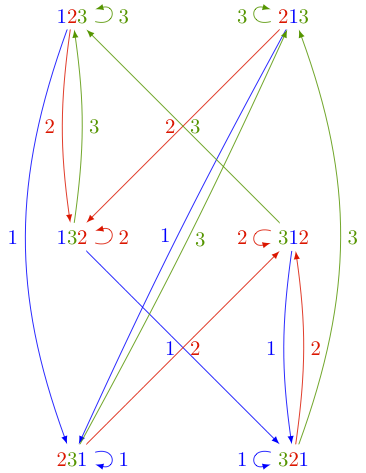The Tsetlin library#
Introduction#
In this section, we study a simple random walk (or Markov chain), called the Tsetlin library. It will give us the opportunity to see the interplay between combinatorics, linear algebra, representation theory and computer exploration, without requiring heavy theoretical background. I hope this encourages everyone to play around with this or similar systems and investigate their properties! Formal theorems and proofs can be found in the references at the end of this section.
It has been known for several years that the theory of group representations can facilitate the study of systems whose evolution is random (Markov chains), breaking them down into simpler systems. More recently it was realized that generalizing this (namely replacing the invertibility axiom for groups by other axioms) explains the behavior of other particularly simple Markov chains such as the Tsetlin library.
The Tsetlin library#
Consider a bookshelf in a library containing
This type of organization has the advantage of being self-adaptive:
The books most often used accumulate on the right and thus can easily be found.
If the use changes over time, the system adapts.
In fact, this type of strategy is used not only in everyday life, but also in computer science. The natural questions that arise are:
Stationary distribution: To which state(s) does the system converge to? This, among other things, is used to evaluate the average access time to a book.
The rate of convergence: How fast does the system adapt to a changing environment .
Let us formalize the description. The Tsetlin library is a discrete Markov chain (discrete time, discrete state space) described by:
The state space
The transition operators are denoted by
We assign parameters
Transition graph and matrix#
One can depict the action of the operators

The above picture can be reproduced in Sage as follows:
sage: P = Poset(([1,2,3],[]))
This is the antichain poset. Its linear extensions are all permutations of
sage: L = P.linear_extensions()
sage: L
The set of all linear extensions of Finite poset containing 3 elements
sage: L.list()
[[3, 2, 1], [3, 1, 2], [1, 3, 2], [1, 2, 3], [2, 1, 3], [2, 3, 1]]
The graph is produced via:
sage: G = L.markov_chain_digraph(labeling='source'); G
Looped multi-digraph on 6 vertices
sage: view(G) # not tested
We can now look at the transition matrix and see whether we notice anything about its eigenvalue and eigenvectors:
sage: M = L.markov_chain_transition_matrix(labeling='source')
sage: M
[-x0 - x1 x2 0 0 x2 0]
[ x1 -x0 - x2 x1 0 0 0]
[ 0 0 -x0 - x1 x2 0 x2]
[ x0 0 x0 -x1 - x2 0 0]
[ 0 0 0 x1 -x0 - x2 x1]
[ 0 x0 0 0 x0 -x1 - x2]
This matrix is normalized so that all columns add to 0. So we need to
add
sage: x = M.base_ring().gens()
sage: Mt = (x[0]+x[1]+x[2])*matrix.identity(6)+M
sage: Mt
[x2 x2 0 0 x2 0]
[x1 x1 x1 0 0 0]
[ 0 0 x2 x2 0 x2]
[x0 0 x0 x0 0 0]
[ 0 0 0 x1 x1 x1]
[ 0 x0 0 0 x0 x0]
Since the SR:
sage: Mt.change_ring(SR).eigenvalues()
[x2, x1, x0, x0 + x1 + x2, 0, 0]
Do you see any pattern? In fact, if you start playing with bigger values of
sage: Mt.change_ring(SR).eigenvectors_right()
[(x2, [(1, 0, -1, 0, 0, 0)], 1),
(x1, [(0, 1, 0, 0, -1, 0)], 1),
(x0, [(0, 0, 0, 1, 0, -1)], 1),
(x0 + x1 + x2,
[(1,
(x0 + x1)/(x0 + x2),
x0/x1,
(x0^2 + x0*x1)/(x1^2 + x1*x2),
(x0^2 + x0*x1)/(x0*x2 + x2^2),
(x0^2 + x0*x1)/(x1*x2 + x2^2))], 1),
(0, [(1, 0, -1, 0, -1, 1), (0, 1, -1, 1, -1, 0)], 2)]
The stationary distribution is the eigenvector of eigenvalues
Optional exercices: Study of the transition operators and graph
Instead of using the methods that are already in Sage, try to build the
state space
For technical reasons, it is most practical in Sage to label the
sage: list(map(tuple, Permutations(range(3)))) [(0, 1, 2), (0, 2, 1), (1, 0, 2), (1, 2, 0), (2, 0, 1), (2, 1, 0)]
Write a function
transition_operator(sigma, i)which implements the operatorsigmaand integersigma[i:j]) and concatenation.Write a function
tsetlin_digraph(n)which constructs the (multi digraph) as described as shown above. This can be achieved usingDiGraph.Verify for which values of
Conclusion#
The Tsetlin library was studied from the viewpoint of monoids in [Bidigare1997] and [Brown2000]. Precise statements of the eigenvalues and the stationary distribution of the probability matrix as well as proofs of the statements are given in these papers. Generalizations of the Tsetlin library from the antichain to arbitrary posets was given in [AKS2013].
- Bidigare1997
Thomas Patrick Bidigare. Hyperplane arrangement face algebras and their associated Markov chains. ProQuest LLC, Ann Arbor, MI, 1997. Thesis (Ph.D.) University of Michigan.
- Brown2000
Kenneth S. Brown. Semigroups, rings, and Markov chains. J. Theoret. Probab., 13(3):871-938, 2000.
- AKS2013
Arvind Ayyer, Steven Klee, Anne Schilling. Combinatorial Markov chains on linear extensions J. Algebraic Combinatorics, doi:10.1007/s10801-013-0470-9, arXiv 1205.7074.